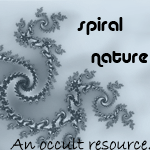Occult ‘zines as cultural artifacts
By Psyche | May 18, 2008 | Print This Post | E-mail This Post | 10 Comments
In Treasure House of Pearls John Crow recently posted about the Theosophical journals he’s been going through in his research on Alan Bennett (interesting stuff, you should check it out). He commented on the “institutional memory” these journals leave behind – an enduring physical record of events that occurred: lectures given, essays shared between countries and their responses.
While his post referred specifically to the Theosophical Society in comparison to the OTO, this echoed my experience with the of the occult ‘zines I’ve been rereading for a project I’m working on.
Many are probably familiar with Kaos and Chaos International, but what about Sut Anubis, Aquarian Arrow, Primal Chaos, The Philsopher’s Stone? With something as disparate as the chaote community, is anyone keeping track? As counter-intuitive as it may seem for an approach aligning itself with chaos, it’s important.
I wasn’t a part of the community that founded chaos magick, and despite ten years of collecting, what I’ve managed to gather seems remarkably sparse. I’ve only got bits and pieces, odd journals – in some cases only a single issue.
A few have been republished as books, Nox, for example, was first released in book form in 1998 by Logos Press, and rereleased by New Falcon in conjunction with Liber Koth as The Infernal Texts, but most appear to have slid into oblivion.
In a later post in his blog, John notes that the Theosophical journals often refer to each other. This incestuousness fostered an exchange that crossed boundaries of geography and culture and challenged their writers and readers to dig deeper into the issues they explored. We see this with many of the chaote and Pagan journals; Sut Anubis announced other magazines recently published, and the letters column of Kaos was one of its most charming features. This kind of literary culture doesn’t seem to exist in the same way today.
In the same post a reader commented that they think “print is (mostly) dead, and the old journals, however worthy, [died] along with them.” This is the kind of sentiment that was popular in the mid to late 90s, libraries were worried that readers would soon have no use for books, and history has proven this, like Y2k paranoia, to be grossly overstated and incredibly misguided.
That said, let’s look at what we have. Some will and have argued that Internet forums fill this gap, but, let’s face it, websites are ephemeral. After a flirtation in the early 90s, I first came online in 1996. The Usenet archives held by Google are incomplete, several people say they have archives of the early zee-list and other mailing lists, but these aren’t easily accessible for those who want to obtain them – most wouldn’t even know where to look. Forums frequently appear for a few years then vanish, their content along with them.
Even were such archives available,1 unmoderated forums are notorious for their lack of quality control – as they should be, the Internet cannot and further should not replace literary journals or DIY ‘zines. They serve an entirely different cultural function – important, but hardly comparable.
The Canadian indie review magazine Broken Pencil is a testament to the enduring tenacity of ‘zine culture as a whole. Where is today’s occult ‘zine culture?
The old ‘zines may be difficult to find, but they’re still out there. For individual collectors the cost can seem prohibitively expensive, especially when the ‘zine you’re looking for sells for 30-50$ when it originally retailed for a only a couple of quid.
I’ll continue collecting the old ‘zines, despite their ever-rising costs (and if you’ve got any hanging around you’d be interested in selling, e-mail me, please!), and I’ll continue checking out new journals as they appear, but they seem to be far and few between.
Footnotes:
- The bulk of the Internet Archive only dates back to 1999, and only the most popular websites are indexed. Private sites and mailing lists archives are not kept. [back]





If you give me some titles, I can ask among some contacts. Otherwise, whatever you archive, I hope you digitize. If so, Digimob could certainly go a long way in permanently democratizing the content.
When comparing chaos magick with other traditions (even quite obscure ones, like the Order of the Cubic Stone), I’ve noticed a sad sparsity of quality-quantity. :(
Namaste.
I’m interested in pretty much everything, with a specific focus on chaote and Thelemic journals and ‘zines, though less interested in Pagan journals unless they’re really outstanding.
It’s highly unlikely I’d reproduce the content without specific permission from the editor or individual authors, however, I would love to see a physical library available to the general public.
I’ve some three and a half thousand books, about a third of them related to philosophy and the occult. These serve as a reference library for a select few (books don’t leave my house unless I’m with them), but that’s not quite the same thing.
There’s been talk for years about creating a public esoteric reference library in Toronto, but it’s been at least four or five years and there have been no obvious developments. This is the sort of thing I’d love to assist with, but I do not currently have the time or resources to spearhead myself.
Regarding quality control issues, yes, that can be a problem for ‘zines in general. Most tend to be self-published, self-edited by their authors or (non-professional) editors. Even so, at least they were doing something, making the effort.
Lulu and CafePress aren’t helping.
Have you been grabbing digimob‘s releases?
If the author’s living and readily accessible, that’s fine and well. Otherwise, it seems rather pointless.
A physical ‘public esoteric reference library’ seems quaint and anachronistic; however, it does certainly coincide with the occult’s long history of classism.
Could you clarify as to what you think Lulu and CafePress aren’t helping with?
It ate my embed, so I’ll resort to a direct link. :P
Information R/evolution
I think ‘zines are even more interesting, in some ways, than the journals of the Theosophical Society. The T.S. knew their publications would be archived and stores. Each year’s volume is bound, numbered, indexed, and put in archives. This is the way it was for all the T.S. libraries. But ‘zines were meant to be ephemeral in some ways. No one expected their ‘zine to last decades and still transmit its message. Yet this is why they are more useful, they act as time capsules to the time; they transmit more than just the written word like a T.S. journal, they are also emotive; they transmit the zeitgeist of when they were created.
Before moving to the Netherlands, I live in Atlanta for sixteen years. Throughout the esoteric community, there are remnants of various time periods and movements. Occasionally I would come across some newsletter or ‘zine from Kerry Thornley’s “Yellow Turban Society,” or some anarchist group that tried to promote its message in the 1980s; other interesting ‘zines came from the early Atlanta Thelemic culture. In each case they not only indicate the message or ideological position, but also the imagery and technology of the time. Were they photocopied or mimeographed? What kind of images did they use? Where the creators headed and what were their messages? These questions are enriched by time and help us understand more than what is said in the words.
‘Zines represented a vibrancy that is often not exhibited today. It was a political vehicle, it was ideological, and it was anti establishment in many ways, and yet, over time, became a standard means of communication. In many ways websites replaced ‘zines, but I don’t think they are the same. They certainly don’t push the same kind of creativity. ‘zine producers had to create something that was entertaining, and often inexpensive. They made collages of images and texts and had to be very creative with their limited means. Sometimes they successes, often they failed.
Does it sound like I am pining for the past? I hope not, because most ‘zines were crap. But still there is something to holding these artifacts from a by-gone era that is meaningful. There are still journals today, though. But computers, desktop publishing, and print-on-demand have allowed the quality to rise, in most cases. The days of the photocopy-collage are long gone. I don’t think we should hearken back, but I do think we should learn from the past. Did the ‘zine creators get their word out? Did they meet their goals? In anything ‘zine should teach us that if you put out a newsletter, you had better be prepared for it to last. One you put it on paper, it has a long shelf life.
‘Zines represented a vibrancy that is often not exhibited today. It was a political vehicle, it was ideological, and it was anti establishment in many ways, and yet, over time, became a standard means of communication.
It’s that dedicated passion that I miss, but then, I’m a fan of punk and DIY culture in general. I admire that strength of will to produce, create and disseminate. Seeds of local culture spread across the globe, forging connections with those who found them.
The Internet is too noisy, especially these days.
By quality rising, I assume you mean production quality? Content-wise I see more rehashing than innovation, book reviews tend to be overwhelmingly positive, and no-one seems interested in seriously criticising another’s work. The conversations seem pointed in one direction, and that passionate exchange seems absent. Something’s missing.
With the proliferation of POD websites like Lulu and CafePress more journals are being created each year, but the word doesn’t seem to be spreading. Or perhaps I’m out of the loop on this?
I missed out on a lot of the ones you named, simply by being younger and a little late to the game, but I collected a local OTO publication called Behutet when I worked at Tower. Unfortunately, they closed, and it was the only place I could find it here in Atlanta. I’ve got about ten issues, and they’ve got some really good, if short, articles and interviews.
I wasn’t aware of them during the first wave either, it’s over time that I’ve found out they existed and through reading them discovered how they both reflected and shaped occult thought in their respective spheres.
I’ve heard about Behutet, and I believe it’s still active and available online. Perhaps I should check them out…
[...] period ‘zines and journals were key,7 like Chaos International, Kaos, The Lamp of Thoth. Excerpts from Liber Nox has recently been [...]
[...] this is the future of occult journals, then it is in very capable [...]